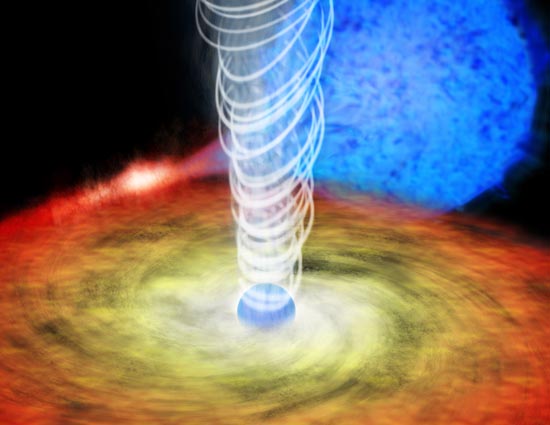Jets from neutron star rival those made by black holes
One of the astonishing qualities of a black hole is its ability to power great jets of energy and matter into space.
Now, using NASA’s orbiting Chandra X-ray Observatory, a team of astronomers led by Sebastian Heinz of the University of Wisconsin–Madison has obtained evidence that neutron stars — the dense, collapsed cores of exploded stars — produce jets that, relatively speaking, rival those produced by black holes.
The new work is important because it reveals the first known neutron star with a powerful large-scale jet, a quality previously attributed only to black holes. Because jets can be diagnostic of extreme objects like black holes and their environments, the new finding may help astrophysicists better understand the nature of both black holes and neutron stars.

This artist’s illustration depicts the jet of relativistic particles blasting out of Circinus X-1, a system where a neutron star is in orbit with a star several times the mass of the Sun. The neutron star, an extremely dense remnant of an exploded star consisting of tightly packed neutrons, is seen as the sphere at the center of the disk. The powerful gravity of the neutron star pulls material from the companion star (shown as the blue star in the background) into a so-called accretion disk surrounding it. Through a process that is not fully understood, a jet of material moving at nearly the speed of light is generated. A high percentage of the energy available from material falling toward the neutron star is converted into powering this jet.
Ilustration courtesy: NASA/Chandra
"We’ve known for a long time that black holes are good at making jets," says Heinz, a UW–Madison assistant professor of astronomy. "This discovery shows that neutron stars are just as good at making jets."
The object, known as Circinus X-1, is actually a pair of stars in mutual orbit, a binary system located in the southern hemisphere constellation Circinus about 20,000 light years from Earth.
The neutron star is locked in a celestial waltz with a companion star several times the mass of the sun. Material from the companion star is drawn by gravity into a spinning disk that spirals slowly toward the neutron star, accreting onto its surface and somehow powering the plasma jets that beam energy and matter into space at nearly the speed of light.
"Jets are these mysterious beams of matter," says Heinz, explaining that astronomers are only beginning to figure out how they’re made and what, precisely, they’re made of. "These are plasma beams that get launched in the inner regions of accretion flows."
The jet observed by the international team of astronomers led by Heinz is about 3 light years long, but it emanates from an object that has a mere 10 kilometer radius. Jets from super-massive black holes, on the other hand, can extend for several million light years.
However, measured on the scale of the object generating it, Circinus X-1 is "certainly very impressive. This is one of the largest jets we know of relative to the size of the object that powers it. In terms of power, it seems to have the same efficiency as a black hole," says Heinz. "This is a critical result. The fact that neutron stars are just as efficient in making jets, despite having shallower gravitational potential and none of the gimmicks that spinning black holes have, is an important new insight."
Some black holes have what are called "ergospheres," which are akin to twisting funnels that suck everything toward the center, forcing matter into a faster and faster rotation. "It is this twisting of space time that occurs around a spinning black hole that people had thought might be responsible for making black hole jets so efficient," Heinz explains.
The Circinus X-1 jets measured by Chandra behave much like jets from black holes: Tightly bundled energy mixed with a pinch of matter is blasted into space like water from a fire hose. When the jets reach the gas of interstellar space, they seem to inflate radio nebulae, lobes of very hot, radio-emitting gas.
Knowing how jets from black holes and other objects work is important because they are thought to be important engines for powering the universe, says Heinz.
"People have realized black holes and jets from black holes are important for energizing the universe. They carry huge amounts of energy in kinetic form, and the release of this energy is very important in terms of how structures form in the universe at large."
The new study will appear in an upcoming issue of The Astrophysical Journal Letters. Co-authors include Norbert S. Schultz of the Massachusetts Institute of Technology, W.N. Brandt of Penn State University and D.K. Galloway of the University of Melbourne.




